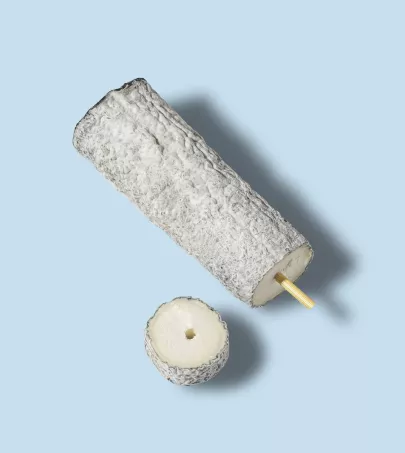
Comté PDO
Bourgogne Franche-Comté
Comté is a cheese with a cooked, pressed rind made in the Jura Mountains using a traditional process. This cheese is shaped by the region's diverse terroir, the work of local cattle ranchers, and the expertise and experience of the cheesemaker and ripener. Every wheel of Comté is unique.
What you need to know
Comté is the number one French cheese in terms of production, with 1.6 million wheels sold annually. Each wheel weighs about 90 pounds and requires 105 gallons of milk to produce. Ninety-five percent of this milk comes from Montbéliarde cows, with the rest from French Simmental cows.
The other secret behind this fantastic cheese is the diary cows' natural diet. These cows have a natural diet of fresh grass in the summer and hay in the winter, which gives the milk—and the cheese—its distinct flavor. The region’s incredible biodiversity, with 576 different plant species, also plays a role in the cheese’s unique taste.
The milk is collected daily from 2,600 family dairy farms and delivered to small village creameries called fruitières, where it’s processed within 24 hours. The creameries, which have been run as co-ops for the past eight centuries, use artisanal production methods and follow a solidarity- and community-minded business model. There are now around 150 in operation.
After the ripening stage, where the milk is skimmed and allowed to rest at 86° F, it’s curdled with lactic ferments. The cheesemaker then uses a curd cutter to break up the curds into small granules, which separate out from the whey. The mixture is then heated to 130 °F to remove any excess liquid.
Next comes the hooping stage, during which the contents of the vat are expelled into perforated molds that let the remaining whey drain out. The cheese is then placed into a press and formed into wheels before the pre-ripening stage. For the next three weeks, the cheeses are regularly salted, rubbed, and turned.
The final and very important stage is aging, where the wheels are transferred out of the creamery and aged into a cheese cave. Through the skill and experience of the cheese ripener, each cheese will take on a unique set of flavors and aromas during this stage.
Differences in Comté Taste Based on Age
French Comté flavor changes dramatically with age. Comté is aged for at least four months but can be left to mature for 24 months or longer. At 4 months it’s smooth and supple with mild nutty notes. As it ages it firms up and the flavors get deeper, revealing a whole range of tastes – from celery leaves and nutmeg to dried pineapple and even baked mac ‘n’ cheese. That’s why Comté has its own flavor wheel.
Comté Cheese Pronunciation
Comté is pronounced “kohm-TAY”. This French cheese is named after the region it comes from, and knowing how to pronounce it will heighten your enjoyment of this luxury.
Comté Cheese Substitutes
If you can’t find Comté, Gruyère is a good substitute. Both cheeses melt well and have a nutty flavor, but Gruyère is a bit sweeter. Beaufort or Emmental are also good alternatives, they have a similar rich, savory flavor to Comté.
Comté Cheese Recipe Ideas
Comté is super versatile in the kitchen. It’s great for melting in fondue or a French croque-monsieur. It’s also good grated over salads, folded into omelets or baked into savory tarts. It adds depth to any recipe.
The History of Comte Cheese
Comté since the Middle Ages
Comté has been made in the Jura region of France for over 1000 years. The history of this famous cheese starts in the Middle Ages, at a time when the local communities had to conserve milk during the long winters. This necessity led to the creation of big wheels of Comté that could be aged for a long time, as a way to keep the milk longer.
The birth of the Fruitières: a cooperative model over 8 centuries
The fruitières, cooperative cheesemaking facilities, were born in the 13th century and are still the heart of Comté today. Farmers would pool their milk together in order to make big wheels of cheese, a system that enabled the rural communities to flourish. The fruitières are the embodiment of the spirit of collaboration and sustainability that is at the heart of Comté.
Monks and farmers in the development of Comté
The monks of the Jura monasteries were also instrumental in the development of Comté.
Along with the farmers, they developed the techniques of production and aging of the cheese. Their innovations ensured the consistency and quality, the base of the cheese we know today.
Anecdotes and little known facts about Comté
Comté Tasting Contests and Awards
Comté is a cheese lover’s favorite, often on show in prestigious tasting contests. These events celebrate its exceptional quality and craftsmanship, awarding Comté cheeses with prizes that highlight their complex flavors and unique characteristics.
Records: The Biggest Wheels and Oldest Comté Aged
Comté is known for big achievements, including some of the biggest cheese wheels in the world, up to 90 pounds each. And while Comté is usually aged between 12 and 36 months, there are some extraordinary examples aged more than 5 years, with an incredible depth of flavor.
Comté in French and international cuisine
Comté is a key ingredient in many French classics. It’s in cheese fondue, gratins and savory tarts. It’s the perfect cheese for Croque Monsieur and adds its nutty complexity to the dish.
While rooted in French cuisine, Comté’s reputation has grown worldwide. Its rich flavor and artisanal quality has made it a favorite among chefs and foodies everywhere. From cheese platters in Paris to gourmet recipes in New York and Tokyo, Comté is shining both in France on the global stage.
Nutritional benefits
French Comté is rich in protein, calcium, phosphorus, copper, zinc, vitamin A, and vitamin B12. Just 1 ounce of Comté provides a third of your daily calcium needs.
Editor's note
Pair with
White wine: Côtes du Jura, Château Chalon, Chablis, champagne, and Châteauneuf du Pape
Red wine: Brouilly, Chinon, and Coteaux Champenois















